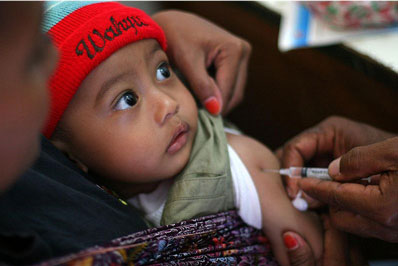Multilateral organisations
Multilateral organisations achieve significant development results and are important partners for the Australian aid program. Their reach, leverage, specialisation and other strengths play a critical role in helping Australia to meet its international development objectives. Around one-third of the aid budget is channeled through multilateral organisations.
Australia assesses the performance of its multilateral partners to inform our engagement with them and to ensure value for money from our multilateral funding. Australia is currently strengthening and improving its approach to the assessment of performance of multilateral organisations in line with the new Australian Aid Policy – Making Performance Count – Enhancing the effectiveness and accountability of Australian Aid to ensure that Australia is working with the most effective partners.
Australia remains committed to working in partnership with our multilateral organisations to strengthen the focus on poverty reduction and increase the effectiveness, relevance and efficiency of multilateral systems.
Why we work with multilateral organisations
The overall effectiveness of Australia's development program has much to do with the quality of partnerships–bilaterally, regionally and multilaterally. Working with multilateral organisations can bring the following benefits:
- Influence–Multilateral organisations can influence countries and resolve an issue when it may be difficult for a single bilateral donor to do so.
- For example, the respect African governments have for the African Development Bank (AfDB) enables the AfDB to play a leadership role on policy dialogue, including on important issues such as anti-corruption.
- Reach and scale–Multilateral organisations are also able to deliver programs where Australia does not have a significant presence or where bilateral assistance is not possible.
- For example, the World Food Programme proved its ability to deliver humanitarian programs in response to the Horn of Africa food crisis on a scale and efficiency beyond the capacity of individual donors.
- Set global policy and standards–The wide membership of multilateral organisations allows global consensus to be built on some of the most pressing international issues, including in areas of humanitarian assistance and development. Without the driving and unifying force provided by multilateral organisations, global consensus would be considerably more difficult to achieve. Their wide membership adds legitimacy and weight to addressing challenging development issues.
- For example, the World Health Organization (WHO), a United Nations agency, established the International Health Regulations (IHR) in 2005. The IHR help the international community prevent and respond to public health risks and diseases that have the potential to threaten people worldwide. The IHR define the rights and obligations of countries to report public health events, and establish procedures that WHO and others must follow to uphold global public health security.
- Expertise–Multilateral organisations bring high levels of relevant expertise and corporate knowledge to their development mandates. They are most often specialist organisations focused on specific development priorities such as gender equality, anti-corruption, sexual and reproductive health rights, and human rights. They are able to effectively mobilise relevant expertise and experience from around the world.
- For example, Australia works with UN Women to support international efforts to empower women and promote gender equality. UN Women was created to bring together the work of four areas across the United Nations to create one centre of expertise that will meet the needs of women worldwide.
- Coordination–At global or regional levels, multilateral organisations can deliver multi-country programs to improve efficiency and help countries share lessons across borders. United Nations agencies work together across borders on issues such as HIV/AIDS, using inputs from organisations such as UNAIDS, the World Health Organisation and the UN Office of Drugs and Crime to effectively tackle the issue on a regional basis. This multi-country role can also be particularly important where countries are small or geographically isolated, such as in the Pacific. At the country level, multilateral organisations have close working relationships with host governments and help coordinate development efforts in line with developing countries' own plans. Improved coordination has the potential to reduce costs for donors. Improved coordination also has positive outcomes for partner governments that might have limited capacity to drive national development agendas.
- An important example of coordination is the role of the United Nations Office for the Coordination of Humanitarian Affairs, which is responsible for the coordination of humanitarian response in natural disasters and complex emergencies. Its mission is to mobilise and coordinate effective and principled humanitarian action in partnership with national and international bodies. It advocates for the rights of people in need, and promotes disaster preparedness and prevention.
- Innovation:–Multilateral organisations are playing a critical role in trialling innovative approaches that could benefit the Indo-Pacific. This includes different approaches to mobilising funds such as Gavi's International Finance Facility for Immunisation (IFFIm) that raises funds for Gavi's vaccine programs by investing long-term donor contributions on capital markets. It also includes innovative approaches to procurement where both Gavi and the Global Fund are bundling demand from developing countries for critical commodities such as vaccines and bed nets. Through such bundling they are able to bring down prices and achieve greater impact than any single partner or country could achieve alone.
- Leverage:–While multilateral organisations are able to extend Australia's geographic reach, our support and active engagement in multilateral funds and organisations also leverage technical support and financing for our region.

